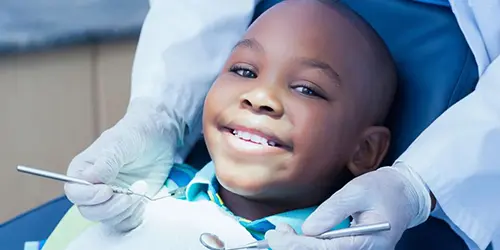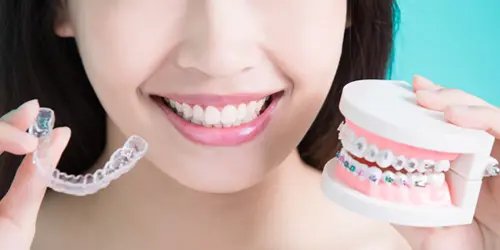Stainless Steel Crowns
Keeping Young Smiles Bright and Healthy
A part of keeping kids happy is keeping their smiles healthy. At PCO Pediatric Dentistry & Orthodontics, we’re here to make it easy for you when it comes to your child’s dental health. We have an array of restorative offerings one of them being dental crowns which help kids with significant tooth decay by restoring their oral health and ensuring proper dental development for their permanent teeth.
Why Choose Dental Crowns for Kids?
Dental crowns are known as effective dental restorations for teens or adults who have unfortunately severely damaged their permanent teeth. Now, you might be wondering, “Why do we need dental crowns for kids’ baby teeth?” Great question! Let’s break it down:
To Crown or Not to Crown: When a tooth has extensive decay, it’s like a tiny fortress under attack. Fillings may not hold the fort against the invaders. That’s where dental crowns come in. Think of them as the superheroes that swoop in to save the day.
The Extraction Alternative: You might be tempted to say, “Just pull the tooth,” but here’s the deal. Extracting a baby’s tooth too soon can lead to a host of complications. We’re talking about potentially having feeding issues (ie. no teeth to eat with), blocked paths for permanent teeth which may lead to the need for orthodontic care, and speech-related problems.
Keeping the Space: Dental crowns let that baby tooth stay put and continue acting as a placeholder until the permanent teeth are ready to make their debut. It’s like having a reserved seat for the new arrivals.
Kids and Their Teeth: We all know kids love to munch on sweets and explore the world with their tiny teeth. But this adventurous spirit can sometimes lead to dental cavities, or “cavities,” as we call them. Don’t worry; it happens to the best of them.
The Baby Teeth Role: Now, you might be thinking, “Aren’t baby teeth just temporary?” Well, yes, they are, but they play a crucial role in your child’s smile and overall oral health. So, they deserve some love and attention.
When Cavities Strike: Sometimes, those little teeth may face extensive decay, and simple fillings might not do the trick. That’s where we step in. If your child’s dentist suggests a dental crown, don’t panic; it’s all about giving your little one the best smile and oral health possible.
Our Trusted Recommendation: The American Academy of Pediatric Dentistry is on the same page as us. They recommend dental crowns as the top choice for kids with significant tooth decay or those who’ve had a pulpotomy, a root canal procedure specially designed for children.
Types of Pediatric Dental Crowns
Aside from being highly effective in preserving perfect smiles in kids, dental crowns also come in different kinds to cater to individual needs.
Stainless Steel Crowns
Stainless steel crowns are the most common choice in pediatric dentistry and for good reason. They’re tough, dependable, and can handle the rigors of a child’s active lifestyle.
- Cosmetic Considerations: While they might not win a beauty contest, these crowns are all about durability and function. They’re perfect for baby teeth where appearance isn’t the top priority.
- Metal Allergy Awareness: In rare cases, stainless steel crowns can cause localized tissue irritation or trigger metal allergies. Rest assured, we’ll discuss all options with you to ensure the best fit for your child.
Stainless Steel Crowns with White Facings
Sometimes, looks matter, especially when front teeth are involved. Stainless steel crowns with white facings offer a more pleasing appearance from the front while maintaining the strength of stainless steel.
- Appearance Matters: The front side looks “white,” which can be a game-changer for some kids. However, keep in mind that the backside remains silver-colored.
- Chipping Alert: While they look great, the white facings can be prone to chipping, especially with teeth grinding or regular wear and tear from chewing. We’ll discuss the pros and cons with you to make an informed decision.
Composite Strip Crowns or Resin Crowns
When prepared skillfully, these crowns are all about aesthetics. Made entirely of composite “white” filling material, they blend seamlessly with your child’s natural teeth. Placing these crowns requires precision and skill. We’ll let you know if your child is a good candidate, and sometimes general anesthesia sedation is recommended for the procedure.
- Maintenance Matters: Composite strip crowns can absorb food stains and discolor if not cared for properly. Regular brushing and flossing are essential to maintaining their appearance.
- Strength and Breakage: They may look stunning, but they’re not as strong as stainless steel crowns. There’s a slightly higher risk of chipping or breaking a piece or corner of the crown.
The Pediatric Crown Placement Process
We understand that the idea of your child receiving dental treatment can be a bit daunting. Let’s break down what happens during the crown placement process so you can feel at ease knowing your little one is in good hands:
01
Comfort Comes First
At PCO Pediatric Dentistry & Orthodontics, your child’s comfort is our priority. Before the procedure, we may recommend using “laughing gas” and/or local anesthesia. Laughing gas is a gentle form of conscious mild sedation to help manage any nervousness or anxiety, and your child remains awake throughout the process.
02
Creating a Dental Fortress
To ensure a smooth and dry working environment, we use a form of isolation whether it be a rubber dam or a soft dry shield. These “fortresses” isolate the tooth being treated, preventing moisture and increasing the dentist’s field of view. Plus, it ensures your child doesn’t swallow any debris.
03
Preparing the Tooth
First, we gently reduce the chewing surface of the affected tooth, outlining the tooth for crown placement. Next, we open up the contact area between neighboring teeth, creating the space needed for the crown. Any decay is meticulously removed from the tooth.
04
The Perfect Fit
Choosing the right crown is crucial. We select, size, trim, and fit the crown to adapt seamlessly to your child’s prepared primary tooth. Both the crown and the tooth are then thoroughly washed and dried separately.
05
Cementing the Crown
Next comes the magic glue—cement, also known as “tooth glue.” We apply it to the insides of the stainless steel crown before fitting it onto the tooth.
06
Biting Down for Perfection
We remove the rubber dam and ask your child to bite down hard on the crown. This step ensures that all excess cement is eliminated, leaving the crown securely in place.
07
The Final Touches
After the excess cement is cleaned off, we carefully floss the tooth contacts to complete the procedure. It’s all about those finishing touches!
WHAT’S NEXT?
If we use local anesthesia during the crown fitting process, your child should avoid eating until the anesthetic wears off to prevent accidental bites to the lip, cheek, or tongue. Once the anesthesia has dissipated, they are free to eat and drink as normal, though the crown may be a bit sensitive. If they experience any discomfort for a day or two after the procedure, over-the-counter pain relievers like Children’s Tylenol or Children’s Ibuprofen can help.
What to Expect After a Stainless Steel Crown Placement
We know that as a parent, you want the best for your child, and that includes their dental health. After your child’s crown is placed, here’s what you can expect:
- Immediate Post-Procedure Period: Due to the possible use of local anesthesia during the procedure, your child’s mouth may remain numb for a little while. This is normal and will wear off gradually.
- No Eating Right Away: To avoid accidentally biting their lip, cheek, or tongue while still numb, your child shouldn’t eat immediately after the procedure.
- Post-Procedure Sensitivity: It’s common for the crown to be a bit sensitive for a day or two after placement. This is a normal part of the healing process.
- Over-the-Counter Relief: If your child experiences discomfort, over-the-counter pain relievers like Children’s Tylenol or Children’s Ibuprofen can help. Just follow the recommended dosages based on their age and weight.
- Eating and Drinking: Once the anesthesia has worn off and any initial sensitivity has subsided, your child can resume their normal eating and drinking habits.
- Good Oral Care: It’s important to continue with regular oral hygiene practices, including brushing and flossing, to ensure the crown and surrounding teeth stay healthy. Our team can guide proper care techniques.
- Regular Check-Ups: Routine dental check-ups are essential to monitor the condition of the crown and your child’s overall oral health.
Reach Out to Us
At PCO Pediatric Dentistry & Orthodontics, we’re here to support you every step of the way. If you have any questions or concerns about their dental crowns for kids in Queens NY or their oral health, don’t hesitate to reach out to our experienced team. We’re just a phone call away.
Join Us in Nurturing Happy Smiles!
Choose Dental Crowns for Kids Queens NY
Get in touch with us today and take the first step towards maintaining your child’s joyful smile. Contact PCO Pediatric Dentistry & Orthodontics now to book an appointment and ensure your little one’s dental health is in expert hands.


